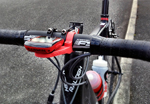5 September 2013
Business start-up exploits additive manufacturing
 Industrial 3D printing of plastic and titanium parts for racing bicycles
Industrial 3D printing of plastic and titanium parts for racing bicycles
Newbury, UK - 29th July 2013. Martyn Harris called on two personal skills last year when starting his new business, RaceWare Direct, to manufacture bespoke plastic brackets for mounting instruments onto racing bikes and to produce titanium components like chain catchers and handlebar stems.
First, he has been a keen cyclist since he was 14 and represented Team GB in 2011, when he won the Track Cycling Masters World Championship in the scratch race for the age category 35 to 39. Second, he is an expert in additive manufacturing, also known as industrial 3D printing, having been employed at 3T RPD in Newbury since 2000, where EOS machines are used to build prototypes and fully functional components from plastic and metal powders, directly from CAD models.
Martyn now splits his time between 3T RPD and RaceWare, which is located next door. The new venture came into being in early 2012, after he tried to buy a mount to secure a computerised power meter safely and neatly to his aero extension TT bars (forward facing extensions to a bike's handlebars that improve aerodynamics in time trials).
He said, "All I could find was a horrible adaptor kit, which included cable ties to lash up the instrument to the bars, so I thought I would make my own mount using the EOS additive manufacturing machines at work. The CEO at 3T RPD, Ian Halliday, was very supportive of my venture and still is.
"I quickly discovered via the internet that a lot of other people were looking for ways to mount power meters, global positioning systems (GPS), cameras and other instruments to their bikes, without using the manufacturers' clunky bracketry. The interest came not just from the TT racing community, but also from road bikers and leisure cyclists."
One of the contacts was cycling enthusiast Jason Swann, who sent through a CAD file of his ideal mount for a Garmin Edge GPS. It took just four months for Martyn to progress from the first iteration to the wide range of products that RaceWare now sells online for mounting Garmin equipment onto road drop bars and aero extensions. They cater for every possible bar size and stem width combination to allow perfect central positioning of the GPS device. The mounts can be painted after vibro-finishing if the customer prefers a neon colour to the white of the EOS PA2200 nylon material from which the products are 3D printed.
Martyn rides for the Banjo Cycles Racing Team, which undertook a six-hour mountain bike endurance challenge using the Garmin mounts to test them under extreme conditions. They were found to be very stiff, with minimal vibration and movement throughout the challenge.
The variety of Garmin mounts manufactured means that batch sizes are small, from 10-off to the low thousands. It would not be cost-effective to produce them by injection moulding, as the tooling would be prohibitively expensive. Building 3D parts directly, layer-by-layer, not only involves much lower initial outlay but also speeds progress from the drawing stage, through honing the design in CAD and 3D printing prototypes, to production of the finished articles.
Martyn continued, "People find it difficult to understand how we produce new parts so rapidly. They ask about lead-time and I reply 'two to three weeks', whereas they are used to hearing six months to a year.
"It allows us to respond very quickly. For example, I produced in a matter of days two bespoke Garmin 500 mounts with lettering down the side saying 'Reading GP 2013', one each for the winner of the men's and ladies' races at a meeting in July."
RaceWare also markets lightweight metal bike parts, which are manufactured additively in EOS machines designed for producing a nest of components, layer-by-layer, from metal powder rather than plastic. In addition to the hollow titanium chain catcher, which is now a commercial product, and the very stiff handlebar stem, which is still at prototype stage, Martyn has just started offering a titanium race number holder and will be looking to introduce more metal parts next year. The powder material used for these applications is EOS Titanium Ti64.
Although RaceWare has been in existence for only 18 months, nearly 6,000 products have already been produced in EOS systems at 3T RPD, which runs six machines for plastic and five for metal. Martyn said that he likes their reliable and consistent performance, which allows high quality parts to be produced during every build. This is important for RaceWare, as in addition to selling its products in almost every country, it supplies numerous elite UK and overseas cycling teams, all of which demand top quality. Many of the most famous cyclists in the world, including those competing in this year's Tour de France, have RaceWare products on their bikes.
Stuart Jackson, Regional Manager at EOS Ltd, the UK & Ireland subsidiary based in Warwick, commented, "This is an outstanding example of how additive manufacturing can be the ideal enabling technology for starting a new business.
"With no up-front tooling costs and the ability to tweak designs along the way, it supports a low cost, innovative culture that brings products to market very quickly.
"Martyn subcontracts his manufacturing to a bureau, so does not bear the costs of investing in our laser sintering machines.
"Even his CAD expertise is bought in, as RaceWare uses the services of Rob Weighill Design, one of four finalists in the Young Designer of the Year category in The Plastics Industry Awards 2013.
"The business model is perfect for a high technology company start-up, as it can leverage an entrepreneur's specialist knowledge, expertise and passion with hardly any financial risk."
- Contact Information
- Name: Stuart Jackson
- Email: stuart.jackson@eos.info
- Website: www.eos.info/en

